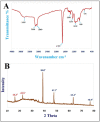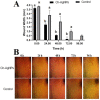Multifunctional Silver Nanoparticles Based on Chitosan: Antibacterial, Antibiofilm, Antifungal, Antioxidant, and Wound-Healing Activities
- PMID: 35736095
- PMCID: PMC9225580
- DOI: 10.3390/jof8060612
Multifunctional Silver Nanoparticles Based on Chitosan: Antibacterial, Antibiofilm, Antifungal, Antioxidant, and Wound-Healing Activities
Abstract
The purpose of this study is to create chitosan-stabilized silver nanoparticles (Chi/Ag-NPs) and determine whether they were cytotoxic and also to determine their characteristic antibacterial, antibiofilm, and wound healing activities. Recently, the development of an efficient and environmentally friendly method for synthesizing metal nanoparticles based on polysaccharides has attracted a lot of interest in the field of nanotechnology. Colloidal Chi/Ag-NPs are prepared by chemical reduction of silver ions in the presence of Chi, giving Chi/Ag-NPs. Physiochemical properties are determined by Fourier-transform infrared spectroscopy (FTIR), X-ray diffraction (XRD), transmission electron microscopy (TEM), dynamic light scattering (DLS), and scanning electron microscopy with energy-dispersive X-ray spectroscopy (SEM-EDX) analyses. TEM pictures indicate that the generated Chi/Ag-NPs are nearly spherical in shape with a thin chitosan covering around the Ag core and had sizes in the range of 9-65 nm. In vitro antibacterial activity was evaluated against Staphylococcus aureus and Pseudomonas aeruginosa by a resazurin-mediated microtiter plate assay. The highest activity was observed with the lowest concentration of Chi/Ag-NPs, which was 12.5 µg/mL for both bacterial strains. Additionally, Chi/Ag-NPs showed promising antifungal features against Candida albicans, Aspergillus fumigatus, Aspergillus terreus, and Aspergillus niger, where inhibition zones were 22, 29, 20, and 17 mm, respectively. Likewise, Chi/Ag-NPs revealed potential antioxidant activity is 92, 90, and 75% at concentrations of 4000, 2000, and 1000 µg/mL, where the IC50 of Chi/Ag-NPs was 261 µg/mL. Wound healing results illustrated that fibroblasts advanced toward the opening to close the scratch wound by roughly 50.5% after a 24-h exposure to Chi/Ag-NPs, greatly accelerating the wound healing process. In conclusion, a nanocomposite based on AgNPs and chitosan was successfully prepared and exhibited antibacterial, antibiofilm, antifungal, antioxidant, and wound healing activities that can be used in the medical field.
Keywords: antimicrobial; antioxidant; chitosan; chitosan/silver nanoparticles; wound healing.
Conflict of interest statement
The authors declare no conflict of interest.
Figures









References
-
- Shehabeldine A.M., Hashem A.H., Wassel A.R., Hasanin M. Antimicrobial and antiviral activities of durable cotton fabrics treated with nanocomposite based on zinc oxide nanoparticles, acyclovir, nanochitosan, and clove oil. Appl. Biochem. Biotechnol. 2021;194:783–800. doi: 10.1007/s12010-021-03649-y. - DOI - PubMed
-
- Salem S.S., Hammad E.N., Mohamed A.A., El-Dougdoug W. A Comprehensive Review of Nanomaterials: Types, Synthesis, Characterization, and Applications. Biointerface Res. Appl. Chem. 2023;13:14. doi: 10.33263/BRIAC131.041. - DOI
-
- Aref M.S., Salem S.S. Bio-callus synthesis of silver nanoparticles, characterization, and antibacterial activities via Cinnamomum camphora callus culture. Biocatal. Agric. Biotechnol. 2020;27:101689. doi: 10.1016/j.bcab.2020.101689. - DOI
LinkOut - more resources
Full Text Sources

